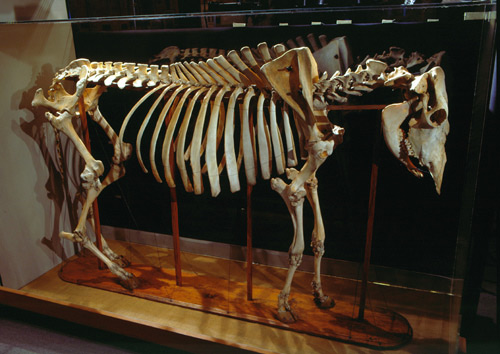
Lesson 6 Forelimb
The forelimb consists of thoracic girdle (Scapula, Coracoid and Clavicle), Arm (Humerus), forearm (Radius and Ulna) and Manus (carpals, metacarpals and phalanges).
THE SCAPULA
It is a flat and triangular bone that forms the skeleton of the shoulder. It has Lateral and medial surfaces Cranial, caudal and dorsal borders. It has cranial, caudal and ventral angles. Lateral surface has supraspinous and infra spinous fossa. Medial surface has two serrated faces and subscapular fossa. Anterior border is thin and posterior border is thick. The dorsal border has scapular cartilage. Ventral angle is expanded into glenoid cavity. Caudal to glenoid cavity is infra glenoid tubercle and cranial to glenoid cavity is supraglenoid tubercle (Tuber scapulae) and medially there is a coracoid process.
HORSE Tuber spinae is present. Spine fades out distally. Acromion process is absent. Sub scapular fossa deep. Two serrated faces clearly triangular. Single glenoid notch. Tuber scapulae is large and an inch away from glenoid cavity.
OX Spine is sinuous (wave like) Tuber spinae is absent. Bone is distinctly triangular. Serrated faces are not distinct. Suprascapular fossa does not reach to distal extremity. Glenoid notch is absent.
THE HUMERUS
A long bone. Shaft is twisted and lateral side is musculospiral groove. On medial surface at proximal one third there is Teres major tuberosity. Anterior surface is triangular, laterally it contains crest of humerus, deltoid tuberosity, Tricipital line and teres minor tuberosity. Distal extremity bears two condyles, lateral one is Capitulum. Lateral Supracondyloid crest
HORSE Bicipital groove is divided by a ridge.
OX Massive lateral tuberosity overhangs the bicipital groove. There is distinct circular rough area on lateral surface of lateral tuberosity for insertion of infraspinatus. Lateral tuberosity is one inch above the level of the head.
THE RADIUS AND ULNA
A Long bone. On proximal extremity two cotyloid cavities and a sagittal ridge and a notch. Radial, medial and lateral tuberosity Distal extremity has three grooves on dorsal surface Distal extremity has three carpal articular surfaces. The ulna is a long bone, attached on caudal surface of radius. Olecranon has anconeal process, semilunar notch and two cranial articular surfaces. Ulna tapers distally. Medial surface of olecranon is concave
HORSE Ulna is much reduced. Ulna reaches up to 2/3rd of the way down the radius. Have single interosseus space. Distal articular surface is sagittal.
OX Ulna is fully developed. Ulna projects beyond the level of radius. Two interosseus spaces, Distal articular surface is oblique.
THE CARPUS
Short bones, present in two rows
HORSE
(MEDIAL) Radial c. Intermediate c. Ulnar c. Accessory c (LATERAL)
(1), 2nd, 3rd, 4th
Accessory carpal articulates both with ulnar carpal and radius bone. Radial carpal is saddle shaped. Intermediate is wedge shaped. Ulnar carpal is irregular. Accessory carpal is quadrangular disc.
OX (MEDIAL) Radial Intermediate Ulnar Accessory (LATERAL)
2/3, 4th
Accessory articulates with ulnar carpal only. Radial is saddle shaped. Intermediate is constricted in the middle. Ulnar carpal is spout shaped. Accessory carpal is rounded.
THE METACARPALS AND DIGITS
Strong long bones. Shaft is compressed craniocaudally. Have cranial and caudal surfaces, lateral and medial borders. Proximal medial surface bears a metacarpal tuberosity
HORSE Third metacarpal (cannon bone) is fully developed. (Mc.2) and (Mc. 4) are vestigial (splint bones). Only third digit is present. 2nd, 3rd and 4th bones are present. Distal extremity bears only one cochlea.
OX Third and fourth metacarpals are fused and weight bearing. Four digits are present of which only third and fourth are fully developed and is functional. 3rd/ 4rth and 5th metacarpal bones are present. Two cochlea divided by a deep notch.


